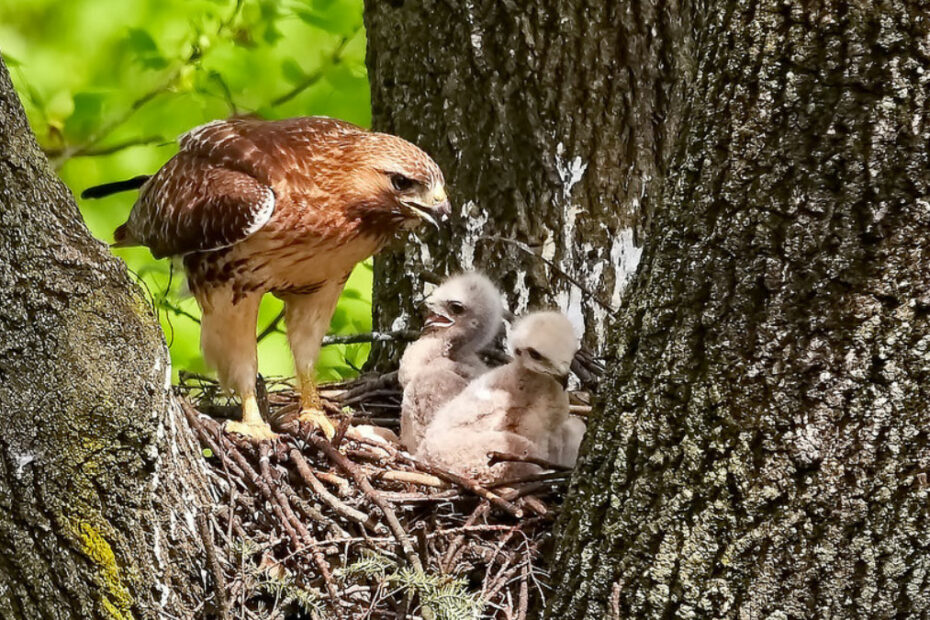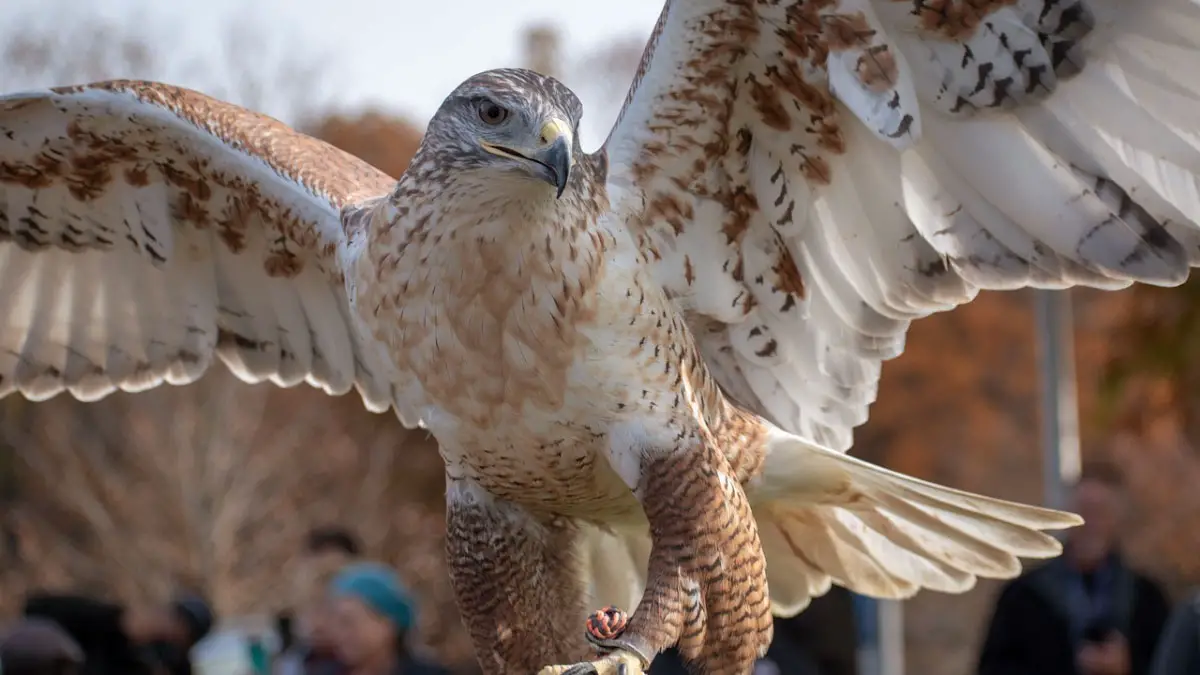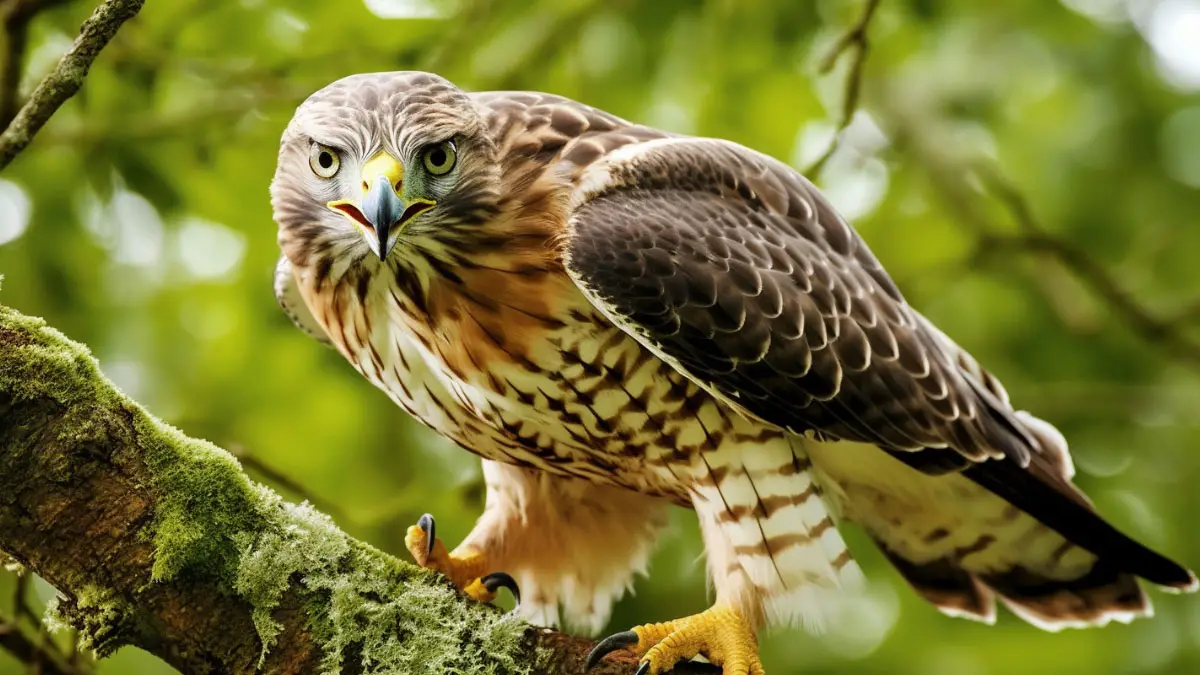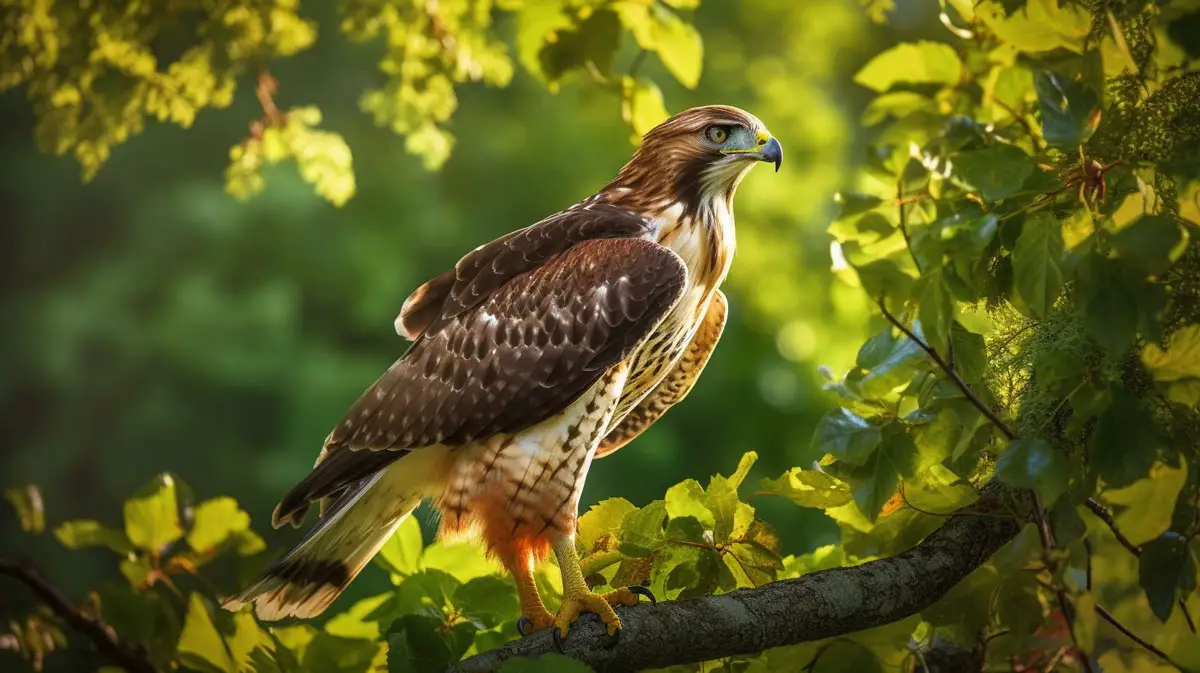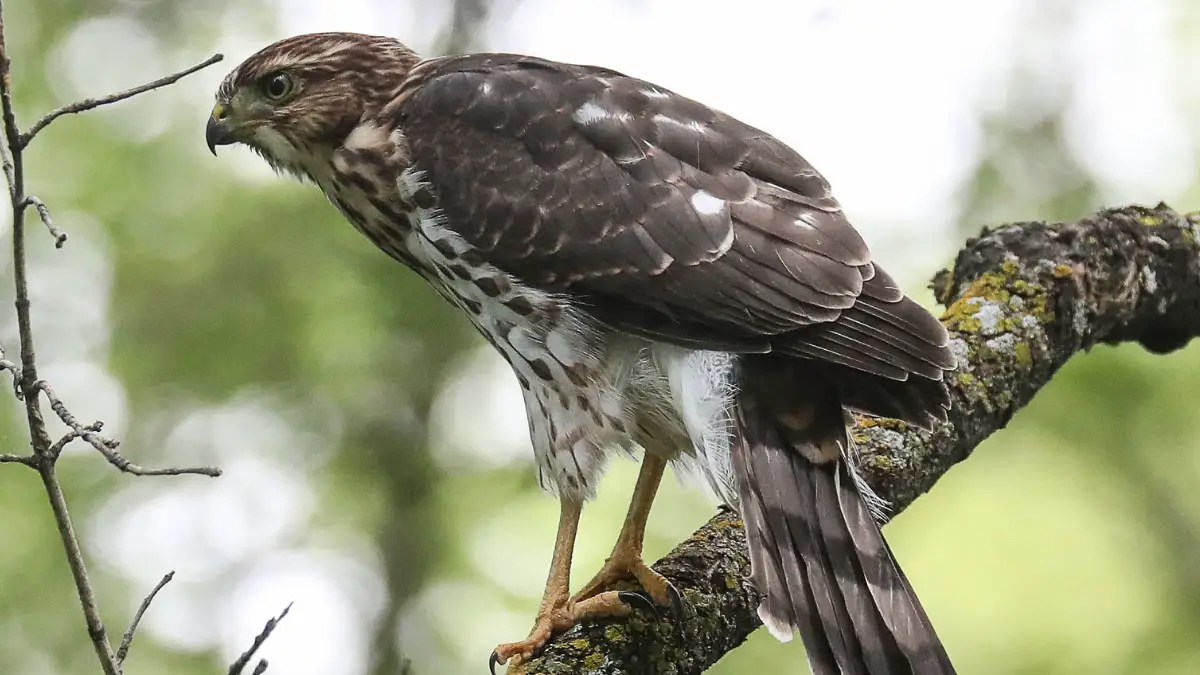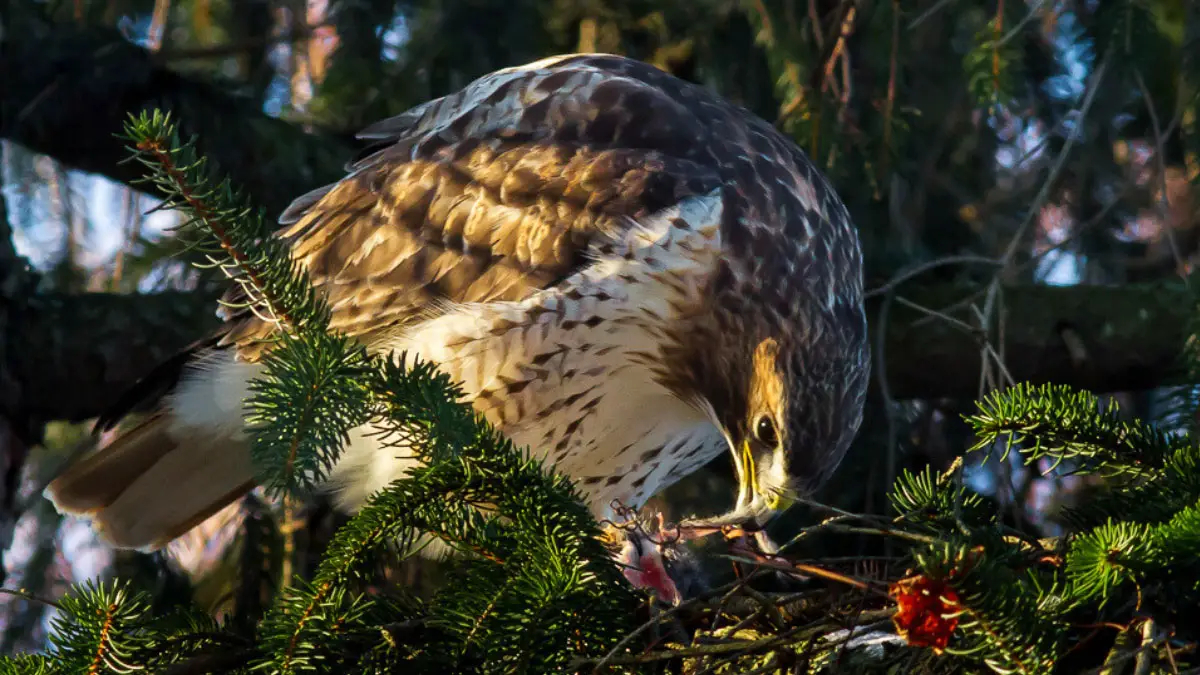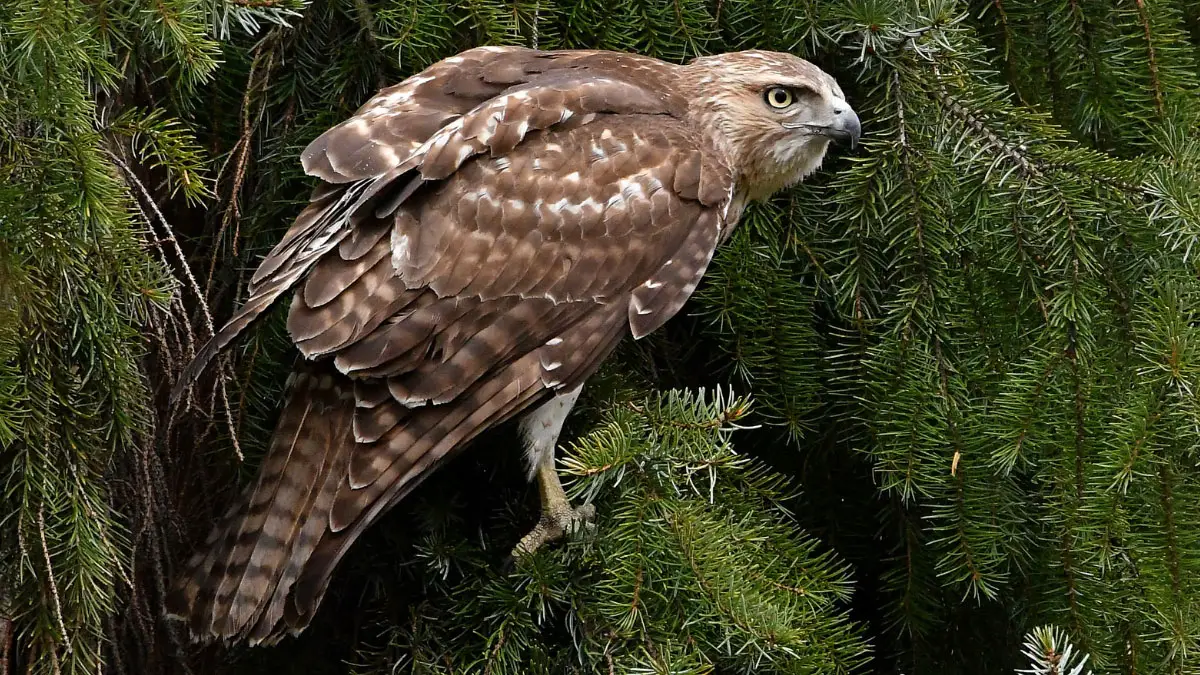Hawks are a group of predatory birds of the family Accipitridae. As such, they must hunt for food, including small mammals, other birds, reptiles, and insects, to survive. As predators, these birds play a vital role in preserving the balance of ecosystems.
By feeding on prey items, such as rodents, rabbits, lizards, insects, and other birds, they help prevent the overpopulation of these animals. In addition, these predatory birds help control the spread of diseases by consuming sick prey. So, the natural reproduction of hawks is important for balancing the ecosystem.
But how and when do hawks mate? These birds mate by engaging in various courtship rituals and displays, such as vocalizations, aerial displays, and grooming each other’s feathers. The vocalizations may vary from one species to another and include screeches, screams, and whistles.
Typically, these birds breed once every year during the spring and summer months. This is between the months of March and August. However, the breeding season of hawks may differ based on the species and location.
Wait, it doesn’t stop there! In this guide, we will discuss everything you need to know about how hawks breed, their nest-building habits, and fledgling development.
An Overview of Hawks Mating, Breeding, and Reproduction
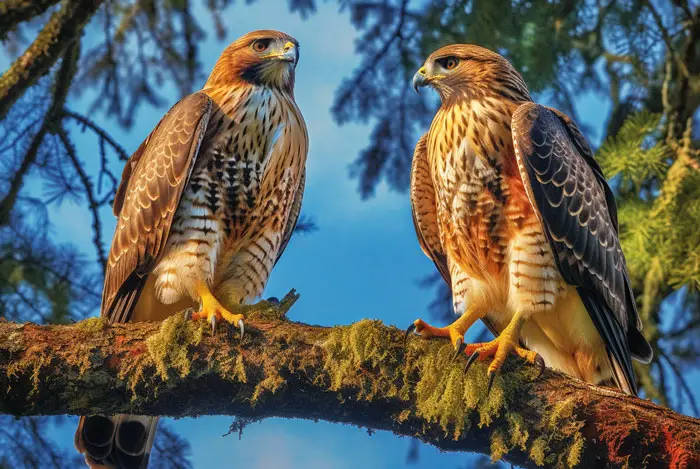
In the section below, we will briefly discuss how these predatory birds mate, breed, and reproduce.
| Aspects | Description |
|---|---|
| Mating and breeding season | Spring and summer months between March and August. |
| Nesting area | High up on the trees, cliffs, rocky ledges, and artificial platforms like telephone poles and tall buildings. |
| Reproduction frequency | All year round, between 1 and 3 times per year. |
| Cluster size | 1 to 8 eggs per clutch. |
| Incubation period | 28 to 35 days. |
| Weaning time | 4 to 8 weeks after hatching. |
Hawk Mating Behavior
Generally, these birds are monogamous. This means they mate with the same partner every mating season. The benefit of hawk monogamy is that it increases the survival of the offspring and helps maintain genetic diversity.
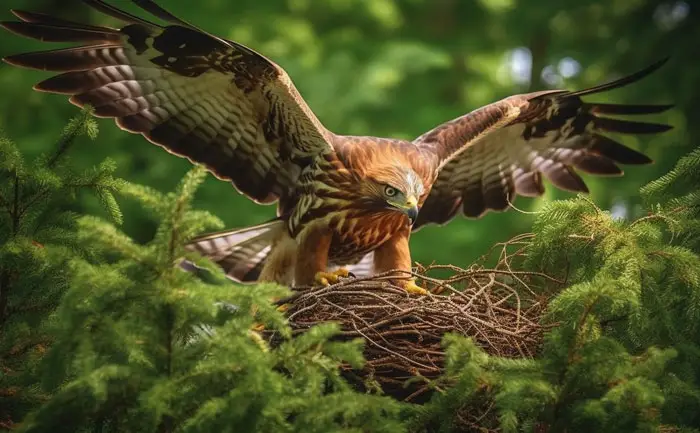
That said, the mating behavior of these birds generally involves a combination of aerial displays, vocalizations, and courtship feeding. These displays may include courtship flights and are usually accompanied by vocalizations like screeches.
By engaging in these different behaviors, the birds create strong pair bonds, successfully breed, and raise their young ones.
Hawks’ Mating and Breeding Season
The mating season for these birds occurs between the spring and summer months. Depending on the species and their geographical location, they may breed from late February to August.
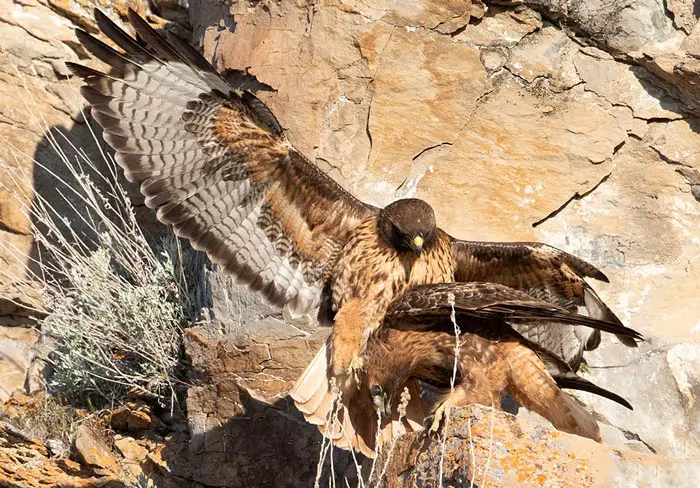
However, species like the broad-winged usually breed between April and August. On the other hand, the red-shouldered species breed between early April and July. Conversely, the Harris hawk breeds all year round from late February to June, laying 2 to 3 clutches per year.
Hawk Courtship Displays and Rituals
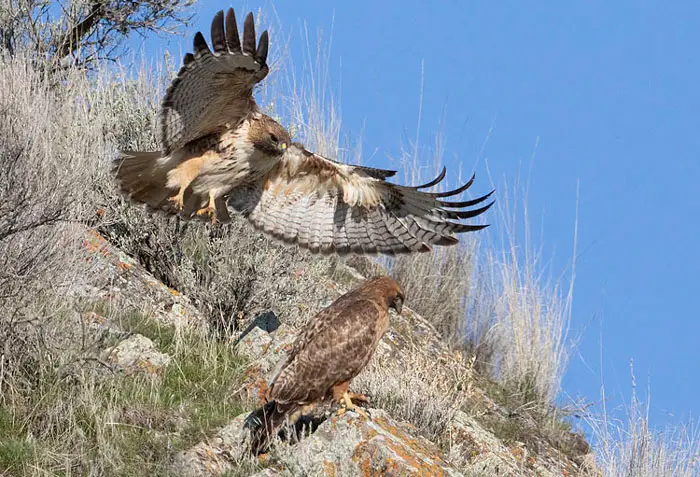
These predatory birds may engage in several courtship displays and rituals to attract mates. Here are a few examples:
- Aerial Display: This hawk courtship behavior involves the male and female gliding and soaring in circles toward one another. The male may dive swiftly from above toward the female.
And when this happens, the female may roll over its talons which may lock with those of the male. During the display, the birds usually scream while soaring in the sky.
- Courtship Feeding: During this ritual, the male bird may bring food to its female counterpart. This is usually to illustrate its capacity to provide for her and the potential youngsters. The female may also do the same as a sign of interest in mating.
- Mutual Preening: Once the female and male birds have formed a bond, they may engage in preening behavior. This involves grooming each other’s feathers, which may help strengthen their bond further.
- Nesting: After bonding, the pair usually work together to build a new nest. Depending on their nesting habits, they can build nests on cliffs or high in the crown of trees.
Factors that Influence Hawk Mate Selection
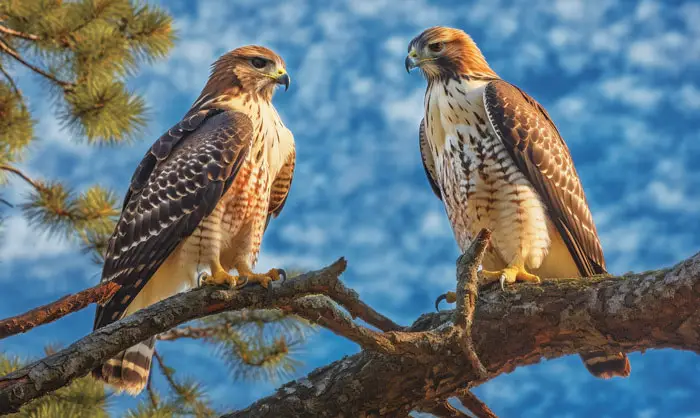
When choosing a mate, these birds may consider several things. These include:
- Size: A larger mate is usually seen as more physically fit and dominant. Therefore, a female hawk may choose a mate with a larger body size or wingspan.
- Color of the Plumage: Brightly colored plumage can indicate good health and genetic fitness. On the other hand, a hawk with dull and faded plumage may be a sign of poor health. So, these birds are likely to choose a mate whose plumage has more vivid colors.
- Courtship Displays: The quality of courtship displays these birds engage may also influence mate selections. Generally, female birds are likely to choose a male that performs impressive aerial acrobatics.
- Physical Fitness: Hawk species may determine the physical fitness of potential mates by checking out their feather’s condition. Birds with shiny feathers are a preferred option.
- Compatibility: These birds prefer mating with individuals they are compatible with in terms of personality and mating style. For example, an aggressive female bird may choose a more dominant male for a mate.
Role of Vocalizations in Hawk Courtship
Hawk species use various vocalizations to communicate with each other during courtship. For example, the red-tailed and Cooper’s hawk species produce piercing screeches and screams. Conversely, species like the American Kestrel make whistling calls. Here is the role these vocalizations play:
- Attraction: Male hawk species are notorious for using vocalizations to attract potential mates. They usually make the calls to announce their presence and readiness to mate.
- Territory: During courtship, these birds may make loud calls to establish the boundaries of their territory. This hawk territorial behavior ensures other bird species don’t come near their nesting sites. On the other hand, the females may make soft calls showing their willingness to accept the male into their territory.
Hawk Nesting Habits
These birds of prey have various nesting grounds and locations depending on the species. Generally, they prefer nesting in trees as these grounds offer a safe and secure location for their chicks.
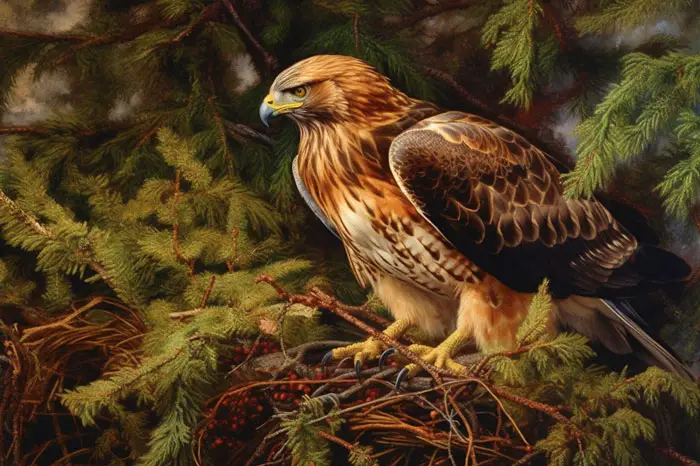
On the other hand, other hawk species favor nesting in open spaces like meadows or fields. These grounds provide them with an explicit view of their environment, allowing them to spot potential prey and predators.
Description of Hawk Nest Building Habits
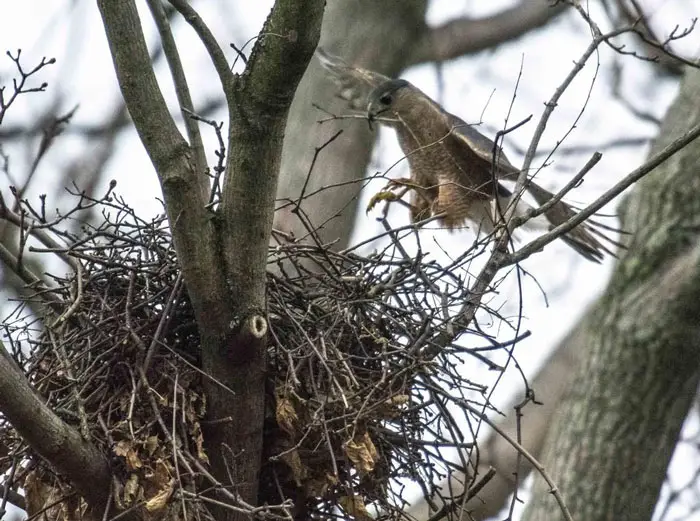
Once the male and female hawk have bonded, the pair may take part in various bird nesting habits. Check them out.
- Choosing Nesting Site: These birds usually pick nesting sites that offer an explicit view of their surroundings. Some of the best nesting sites for these species are tall trees, telephone poles, cliff ledges, and tall buildings.
- Gathering Construction Materials: After choosing the nesting site, the male and female usually start collecting building materials. These include grasses, twigs, sticks, leaves, and feathers.
- Building the Nest: Both sexes usually play a role in hawk nest building. The birds may spend several months constructing and repairing their nests. They may also constantly add new materials to ensure the comfort and safety of their chicks.
Factors that Influence Hawk Nest Site Selection
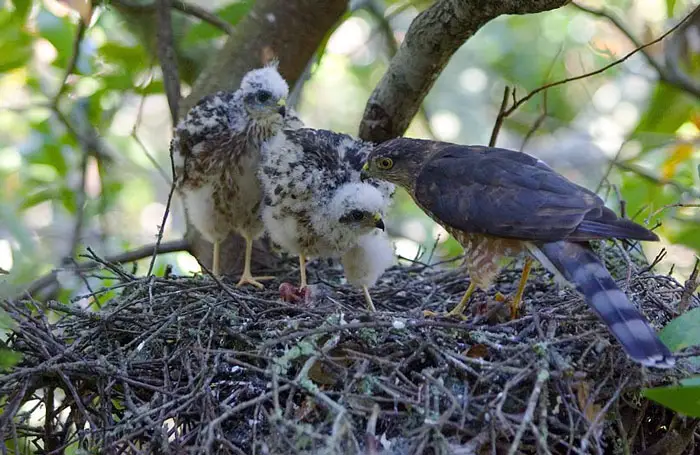
Hawk species may choose a nesting site by following the aspects below.
- Safety: A hawk will choose a nest site located high up in trees, man-made structures, or cliffs for safety reasons. Such a nest site allows these birds to avoid predators as much as possible.
- Food Accessibility: Additionally, these raptors prefer nesting sites located near reliable food sources. These include near water bodies, in young, denser forests, or in open fields. This is to ensure they can comfortably feed their chicks.
- Environmental Conditions: Typically, these birds may favor sites that offer adequate shelter from harsh weather conditions like rain or wind. On the other hand, some species may prefer to nest in warmer and more temperate environments and others in colder climates.
- Nesting History: In addition, these predatory birds may select nest sites based on past nesting success. If a site was favorable in the past, the birds are more likely to hand-pick it again in the succeeding years.
Overview of Hawk Nest Structure and Materials
Hawk nests come in different shapes and sizes, with high walls to keep the eggs and fledglings from falling out. But generally, these nests are usually between 3 and 4 feet wide, depending on the bird’s size.
For example, the nest of a red-tailed hawk is in the range of 2 to 3 feet big. Regarding the shape, the nests can either be round or oval.
Typically, the basic structure of hawk’s nests comprises sticks, grasses, twigs, and plant materials. The nest may also be covered with fresh leaves, husks, stalks, pine needles, bits of cloth, and feathers.
Leaves, feathers, and grasses usually serve as lining materials, offering superior comfort for the young ones.
Hawk Clutch Size and Incubation
The hawk clutch size differs from one species to another. For example, the red-tailed species have a clutch size of 1 to 5 eggs. On the other hand, the clutch size of the sharp-shinned species ranges from 3 to 8 eggs. Conversely, Cooper’s hawk may lay 3 to 6 eggs per clutch.
Meanwhile, the incubation process usually starts after the female has laid her first egg in the nest. However, the length of this process ranges between 28 and 35 days. It varies based on the hawk species and environmental conditions.
For example, the incubation period of the Harris hawk is around 32 days, while that of the red-tailed species is 28 days. Throughout this period, the birds sit on the eggs and rotate them regularly.
Role of Male and Female Hawks During Incubation
Both the male and the female bird take turns to incubate the eggs, keeping them at a constant temperature. The recommended temperature is between 99-and-100 degrees Fahrenheit. Apart from that, the pairs also safeguard the eggs from predators, such as raccoons and squirrels.
However, the female usually does most of the incubation while the male goes looking for food. And once the male returns, it takes over incubation.
For some species, like the Cooper’s hawk, the roles may change. In this case, the female usually hunts while the male incubates the eggs for short periods.
Factors that Affect Hawk Incubation and Clutch Size
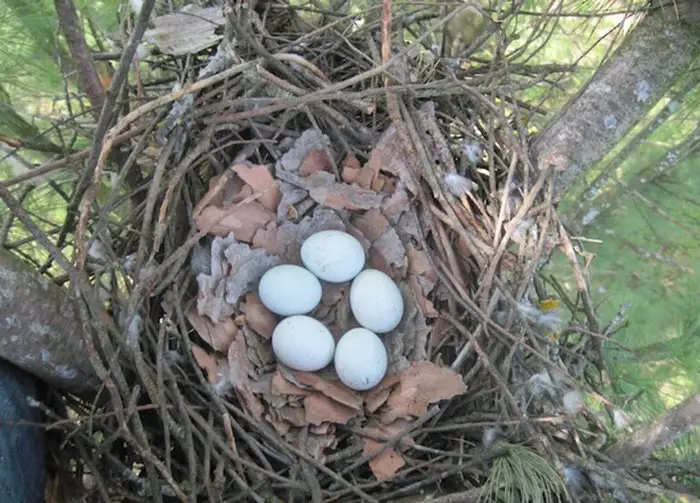
The incubation success rate of these birds and their clutch size may vary based on the following factors:
- Availability of Prey: When these birds have access to abundant prey, they are likely to lay sizable clutches and experience a higher incubation success rate. This is because they have the energy to raise a larger brood.
- Quality of Nesting Site: Hawk species with access to safe nesting sites are likely to lay larger clutches. This is because their young ones will be less prone to predation compared to those in insecure nesting locations.
- Size and Age of the Female: Generally, larger and mature species tend to lay bigger clutches than their smaller counterparts. Simply, clutch size and incubation success usually increase with age.
Raising Hawk Chicks
After the incubation period has elapsed, the hawk chicks usually hatch from the eggs. Typically, the chicks may take over 12 hours to break out of the eggshell.
Once the chicks hatch, they enter the nestling stage. In this stage, the nestlings usually depend on their parents for food and warmth. Over the next couple of weeks, the chicks grow expeditiously and develop a coat of feathers. They also become more active, exercising their wings in preparation for the fledgling stage.
Role of Male and Female Hawks in Chick Rearing
Both male and female hawks play a critical role in chick rearing. Generally, the female hawk helps keep the chicks warm in the nest. She also helps feed the young ones, ripping up the food and feeding it to them little by little.
On the other hand, the male bird normally takes charge of providing food for the chicks and their mother. The male also offers protection to the chicks against predators.
Explanation of Hawk Chick Diet and Feeding Habits
During bird chick rearing, the diet of baby chicks differs based on the prey available in their environment and hawk species. But generally, the diet of these young ones mostly comprises insects, crustaceans, lizards, and fish.

Additionally, the chicks eat birds, such as songbirds, pigeons, and doves, as well as small mammals, including mice, rabbits, voles, and rats. But because of their bigger size, the female bird must cut them into bite-sized pieces.
Regarding their feeding habits, the female delivers the food directly to the chick’s beak. The food is usually partially digested by the parent. And because of their high metabolic rate, the chicks usually feed several times per day.
Factors that Affect Hawk Chick Development and Survival
While raising hawk chicks, their development and survival may be affected by various factors. These are:
- Food Availability: The chicks need a stable food supply to support their growth and development. If food is scarce, they may not get adequate nutrition, and this may lead to poor growth, reducing their survival.
- Parental Care: The quality of hawk parental care is also critical. If the parents fail to offer their nestlings adequate care, this may affect their chances of survival.
- Weather Conditions: Harsh weather conditions like prolonged periods of rain may reduce prey availability. Weather conditions may also affect the parent’s ability to hunt successfully. This may impact the chick’s development and survival due to poor nutrition.
Hawk Fledgling Development
Young chicks usually fledge or leave the nest when they are between 42 and 46 days old after hatching. During the fledgling stage, the parents are still responsible for providing the juveniles with food. This is because the chicks still stay close to the nest for 2 to 4 more weeks until they develop robust flights.
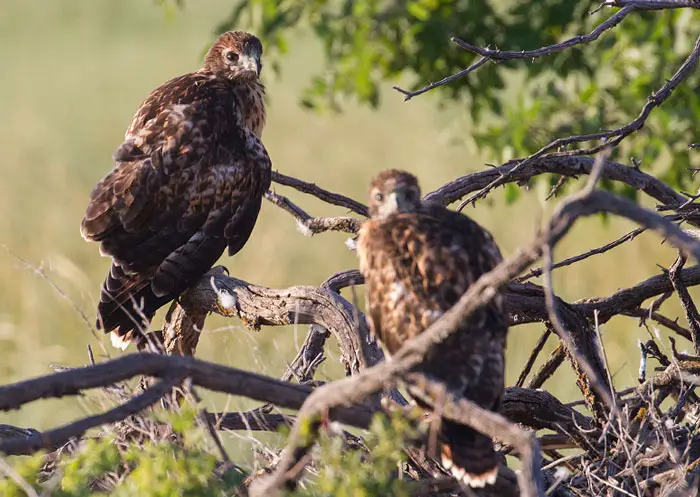
The fledgling period is a very critical time because this is the time the young ones learn to fly. The chicks also start developing the skills required to survive in the world.
Overview of the Fledgling Process of Hawks
During the fledgling process, the juvenile birds spend a couple of weeks flapping their wings and hopping around. This helps them develop flying muscles in preparation for their first flight.
You may see the young birds perching on low branches. And as they take their first flight, they may land on the ground. This entire process of practicing how to fly may take 2 or more weeks. Once they learn how to fly, the birds start hunting for food to supplement what their parents provide for them.
Role of Male and Female Hawks During Fledgling
During the hawk fledgling development, the male and female birds provide the juveniles with food. The parents also monitor the young ones as they learn to fly.
In addition, they defend them against potential predators and other threats. The parents also teach the juveniles hunting and defensive skills.
Factors that Affect Fledgling Survival
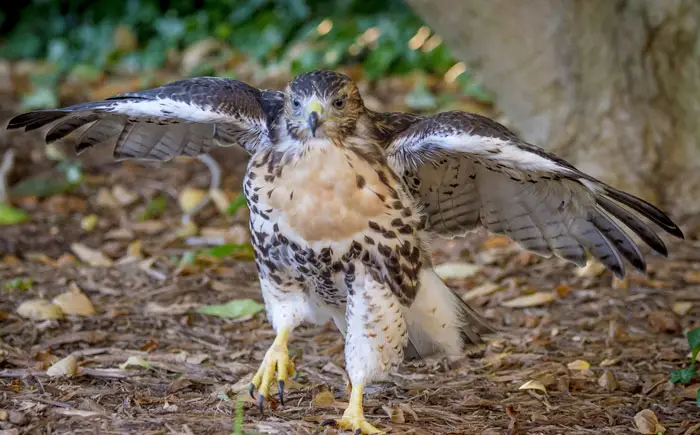
While the average hawk life cycle is 10 to 15 years, most mortality occurs during the fledgling stage. Below are the factors that affect fledgling survival.
- Predation: As the juveniles learn to fly, they are usually more vulnerable to predator attacks. This makes it difficult for them to survive.
- Food Availability: During the first weeks as fledglings, hawk chicks lack hunting skills. Therefore, if the parents don’t provide them with adequate food, it may reduce their chances of survival, like their juvenile period.
- Human Activities: In urban areas, the fledglings are usually highly susceptible to accidents, which affects their survival. This happens when the juveniles come into contact with power lines, cars, and tall buildings.
Conclusion
Hawk’s bird mating behavior may vary from one species to another. However, all species employ a combination of aerial displays and vocalizations during courtship. In addition, different species have contrasting nest-building habits, nesting grounds, and nest sites.
Apart from different nesting behaviors, these predatory birds also boast distinct clutch sizes and incubation periods. However, when it comes to raising their chicks and fledgling development, the process is the same for all species.
With that said, understanding hawk reproduction is very critical for conservation efforts. This is because it enables conservationists to monitor the population trends of these birds. More so, it helps in identifying the potential threats to the survival of these birds.
Additionally, understanding the breeding behavior of hawk species helps identify their nesting sites. This allows conservationists to protect these sites through habitat restoration efforts.
As we conclude, more studies are needed on how to monitor these birds’ populations and any changes in their bird breeding cycles. There is also the need for more research to identify the factors that influence hawk’s nest site preferences. This information can then be used to protect their critical nesting sites.
